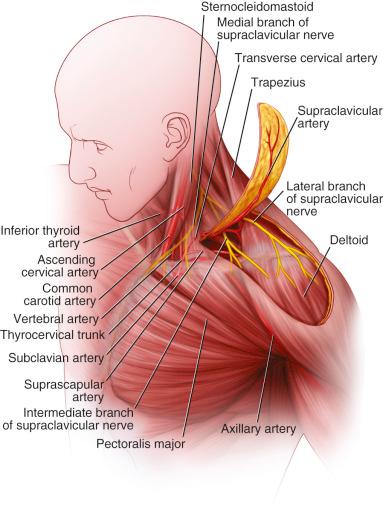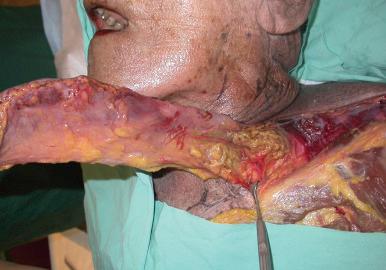Physical Address
304 North Cardinal St.
Dorchester Center, MA 02124
The supraclavicular flap was reported first by Lamberty in 1979. The flap was not reported on further until Pallua reported its use in cases of neck contracture reconstruction in 1997. Since that time, the flap has been widely used and reported on. The supraclavicular flap has been favored for head and neck reconstruction due to its match with color and texture of the recipient head and neck skin. The supraclavicular flap has been described for resurfacing the neck in cases of contracture and resurfacing the face in cases of burns, sternal reconstruction, tracheal-stomal reconstruction, esophageal reconstruction, facial recontouring, and more.
The supraclavicular flap is a fasciocutaneous flap that occupies the area around the clavicle that extends over the deltoid muscle. It is similar to the area utilized in an extended deltopectoral flap. Since the vascular pedicle lies above the clavicle, it has a better arc of rotation to the head and neck area than the deltopectoral flap and can often be closed primarily. For uses below the clavicle, the deltopectoral flap may be preferred. The average width of the flap that can be closed primarily is 7 cm, and the flap is reliable without a vascular delay to level of the insertion of the deltoid over the humerus. Because of its location over the clavicle and chest, it is commonly used with tissue expansion, which allows stable expansion of the skin and easy donor site closure.
supraclavicular artery
Length: 7 cm (range 1–7 cm)
Diameter: 1–1.5 mm

The supraclavicular artery is a branch of the transverse cervical artery ( Fig. 33.1 ). The transverse cervical artery arises from the thyrocervical trunk. The thyrocervical trunk comes off the first portion of the subclavian artery, located distal to the vertebral artery takeoff and proximal to the costocervical trunk. The branches of the thyrocervical trunk include the inferior thyroid artery, the suprascapular artery, the ascending cervical artery, and the transverse cervical artery. The transverse cervical artery runs laterally in front of the anterior scalene muscle to supply the flap.
The artery runs axially through the flap for an average of 7 cm in length. The vessel only has a diameter of 1–1.5 mm at the origin. The supraclavicular artery can be found within the triangle composed of the sternocleidomastoid muscle anteriorly, the clavicle inferiorly, and the trapezius muscle, posteriorly ( Fig. 33.2 ). Within this triangle the vessel is anterior to the external jugular vein when identifiable. The artery can also be found relative to other landmarks: 8 cm lateral to the sternoclavicular joint, 2 cm posterior to the sternocleidomastoid muscle, and 3 cm above the clavicle.

the vena comitantes accompanying the arteries
Length: 7 cm (range 1–7 cm)
Diameter: 2.5 mm at its origin
Venous drainage from the supraclavicular region includes both the external jugular vein laterally and the internal jugular vein centrally. Once elevated, the flap drains primarily to the internal jugular system.
Venous drainage parallels the arterial supply of the flap via vena comitantes that run with the supraclavicular artery. These comitantes drain into the transverse cervical veins that ultimately join the internal jugular vein.
the supraclavicular nerves (C3, C4)
none
The supraclavicular nerves derive from the C3 and C4 nerve root and supply the supraclavicular area extending beyond the clavicle on to the anterior chest. They emerge from beneath the posterior border of the sternocleidomastoid muscle and descend into the posterior triangle of the neck beneath the platysma and the deep cervical fascia. It is near the clavicle that they perforate the fascia and the platysma to become cutaneous.
The supraclavicular nerve has three distinct branches: the medial branch, the middle branch, and the lateral branch. The medial branch crosses obliquely over the external jugular vein and the clavicular and sternal head of the sternocleidomastoid muscle. This supplies the skin as far as the midline and supplies the area of the sternoclavicular joint. The middle branch crosses the clavicle and supplies the skin over the pectoralis major and deltoid muscles, communicating with the cutaneous branches of the upper inner costal nerves. The lateral branch passes obliquely across the outer surface of the trapezius and the acromion to supply the skin of the upper and posterior shoulder and supplies the acromial clavicular joint area.
The supraclavicular flap can be harvested as a pedicled fasciocutaneous flap or as a free flap. The flap is most commonly used as a pedicled flap. Flap provides thin skin with thin subcutaneous fat and fascia.
The vascular supply is reliable and consistent.
This supraclavicular artery is usually not disrupted after a modified radical neck dissection, commonly encountered in head and neck cancer patients.
The color and texture of the supraclavicular area match the color and texture of non–hair-bearing facial skin.
Its use as a pedicle flap does not require expertise in microsurgery.
Morbidity is limited as no muscle is taken with the flap and no critical nerves are sacrificed.
Primary closure of the donor site may be obtained with flap widths of ≤7 cm.
Large amounts of tissue can be generated using this flap combined with tissue expansion.
Harvest is rapid and straightforward. Identification of the primary pedicle is not required to elevate and use this flap.
With preservation of the supraclavicular nerves, this flap can be sensate.
The blood supply to this flap may not be available due to previous surgery or radiation. CT angiography or MRA can be performed preoperatively to confirm vessel patency.
The length of this flap may be limited beyond the numeral insertion of the deltoid without surgical delay.
Flap width of >7 cm may require skin grafting.
The flap does not provide hair-bearing skin for lower facial and neck reconstruction in men.
All patients should be examined before raising the flap. Any neck scars or deformities that might interfere with the vascularity or the design of the flap should be noted. The contralateral supraclavicular area should also be examined as an alternative to the ipsilateral flap.
The supraclavicular flap can be performed in patients of all ages and in both sexes. There may be some distortion of the breast in female patients, depending on skin laxity and the size of the flap harvested. In obese patients, excessively thick subcutaneous tissue may make the supraclavicular flap unsuitable for reconstruction of some defects.
Medical comorbidities generally do not limit the utilization of this flap. However, medical comorbidities such as cardiac or pulmonary disease, should be optimized preoperatively.
Become a Clinical Tree membership for Full access and enjoy Unlimited articles
If you are a member. Log in here